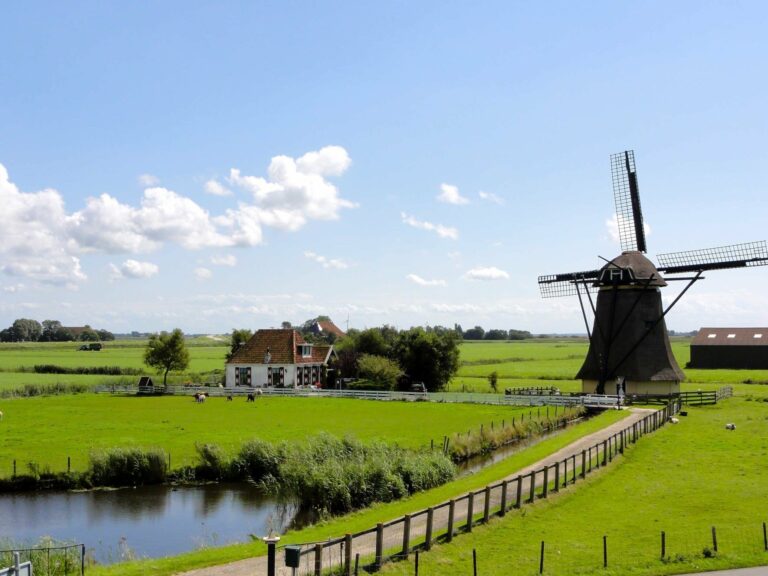Exploring Dutch cuisine reveals an array of delicious foods. Stroopwafels, with their sweet syrup filling, are a delightful treat. Bitterballen offer a savory experience with their deep-fried meaty filling. These dishes are just the beginning. Dutch pancakes vary from sweet to savory and make a satisfying meal, while erwtensoep, a thick pea soup, provides comforting warmth on cold days. Poffertjes, small fluffy pancakes, are impossible to resist.
Let’s delve into Netherlands’ culinary scene and discover why each dish is a must-try.
Nederländerna boasts an impressive culinary heritage. For instance, stroopwafels are not just sweet; they’re a harmonious blend of cinnamon-infused dough with a caramel-like syrup, often enjoyed with a warm beverage. Bitterballen are a hit at social gatherings, encapsulating a mix of beef or veal, broth, butter, flour for thickening, and spices, all coated in breadcrumbs and fried until golden.
Dutch pancakes, or pannenkoeken, are larger and thinner than their American counterparts and can be topped with fruits, or filled with cheese and bacon for a savory twist. Erwtensoep, also known as snert, is a staple during the Dutch winter, loaded with split peas, pork, and vegetables, making it a hearty meal. Poffertjes, often dusted with powdered sugar and a pat of butter, are a treat you’ll find at markets and fairs.
Each dish reflects the Netherlands’ history and regional produce, showcasing a cuisine that is both comforting and diverse. So, as we explore these Dutch favorites, we’re not just tasting food; we’re experiencing the Netherlands’ rich cultural tapestry.
stroopwafel
Stroopwafels are a beloved Dutch confection that delights anyone with a penchant for sweets. Originating in the late 1700s in Gouda, a baker innovatively repurposed leftover crumbs and syrup into this scrumptious treat. Over time, stroopwafels have woven themselves into the fabric of Dutch culinary tradition, cherished by both residents and visitors.
These confections are more than just sweets; they’re woven into the fabric of Dutch celebrations, often enjoyed during special events like weddings and birthdays, as well as national holidays. Sharing a stroopwafel is a gesture of unity and warmth, reinforcing social bonds and contributing to a joyful atmosphere.
Stroopwafels vary in form across the Netherlands, with each region boasting its own distinctive twist. For example, Amsterdam offers bite-sized stroopwafels ideal for on-the-move indulgence, while Rotterdam’s version is notably larger and denser, providing a hearty chew. Despite these regional differences, each stroopwafel variation promises a delightful taste experience.
Whether you favor the classic slender, crisp stroopwafels or the chunkier, more toothsome kind, these treats cater to all preferences. Their storied past and cultural relevance, paired with the assortment found throughout the Netherlands, make stroopwafels an essential experience for anyone visiting the country.
Dive into the sweetness and rich, buttery flavor of a stroopwafel and savor a piece of Dutch history.
bitterballen
Delving into Dutch culinary traditions, I eagerly anticipated sampling another local specialty. My palate wasn’t disappointed when it encountered the robust flavor of Bitterballen.
For those keen to recreate this Dutch delicacy at home, here are some straightforward steps:
- Combine beef or veal with a thick, roux-based gravy.
- Shape the mixture into small, round balls before rolling them in breadcrumbs.
- Fry these until they’re golden and have a crunchy exterior.
- Enjoy them piping hot, paired with mustard for an extra zing.
The origins of Bitterballen can be traced back to the 17th century and were once a symbol of affluence among the Dutch aristocracy. Nowadays, these savory snacks are a cherished element of the Netherlands’ gastronomic heritage, commonly found in bars and restaurants as a starter or snack.
Bitterballen’s true value lies in their role in Dutch social life. They aren’t just food; they’re a medium for connection. Gathering with friends at a pub or serving them at family events, these flavorful morsels foster togetherness. Perfectly complemented by a chilled beer or Dutch jenever, their crispy shell and rich, meaty center are truly tempting.
In every crunchy bite, Bitterballen encapsulate the essence of Dutch culture, representing both historical tradition and the joy of communal dining.
sill
Herring, a key component of Dutch culinary heritage, offers a taste of the Netherlands’ storied connection with the sea. Known locally as Hollandse Nieuwe, this gleaming fish is a treat for anyone fond of seafood. For generations, herring has been a cornerstone of Dutch dining, reflecting its significance in their food culture.
The traditional method of savoring herring is in its raw form. After careful cleaning, the fish is salted and left to cure for several days, which leads to a soft, richly flavored delicacy. Typically, it’s eaten from head to tail, minus the tail itself. You can expect a briny, mild fish flavor complemented by a luxuriously silky texture that’s sure to please the palate.
For those eager to try making Dutch herring dishes at home, the possibilities are vast, ranging from pickled herring to hearty herring sandwiches. Dutch recipes for herring are the product of long-standing traditions, honed over many years.
Participating in a herring festival in the Netherlands is a wonderful way to dive into the world of herring. These events mark the start of the new herring season and present the perfect opportunity to sample this specialty in its prime. Amidst a backdrop of festive music and dance, these festivals offer a vibrant slice of Dutch culture.
Herring stands as more than mere seafood in the Netherlands; it embodies a piece of national identity. When visiting, embracing this seafaring treat is a must for a complete Dutch experience, and it’s sure to leave a lasting impression.
Holländska pannkakor
Pannekoeken, the Dutch variation of pancakes, are a beloved component of the culinary heritage in the Netherlands. Known for their delightful fluffiness and array of toppings, these pancakes aren’t just for breakfast – they’re a treat for any meal.
Here’s why you should indulge in Dutch Pancakes the next time you’re in the Netherlands:
- Variety in Dutch Pancake Recipes: Dutch Pancakes come in a multitude of flavors, catering to all tastes. You can savor the traditional dusting of powdered sugar and a dollop of butter, or explore unique combinations such as pancakes laden with bacon and cheese. For those with a sweet tooth, the apple or raisin pancakes are a must-try, offering a fruity surprise in every bite.
- Favored Toppings for Dutch Pancakes: The options for dressing up your Dutch Pancake are infinite. Popular choices range from the sweet harmony of Nutella and banana to the classic pairing of strawberries and whipped cream, or a simple yet satisfying pour of maple syrup. If savory is more your style, consider toppings like crispy bacon, gooey cheese, earthy mushrooms, or savory ham.
- Thick and Fluffy Texture: Distinct from other pancake varieties, Dutch Pancakes are celebrated for their thick and fluffy consistency. This irresistible texture is achieved by mixing flour, eggs, milk, and just a hint of salt into a batter that cooks up into pancakes so airy, they seem to dissolve in your mouth.
- Personalized Pancake Experience: The true charm of Dutch Pancakes lies in their adaptability. You’re the artist, with the pancake as your canvas and toppings as your palette. Whether your preference is sweet indulgence or a savory feast, you can craft a Dutch Pancake that’s uniquely yours.
Dutch Pancakes are more than just a dish; they’re a reflection of the Netherlands’ rich gastronomic culture. The next time you find yourself in this European culinary hotspot, make sure to embrace the experience of enjoying an authentic, fluffy, and customizable Dutch Pancake.
ärtsoppa
Erwtensoep, also widely known as snert, embodies the essence of Dutch winter comfort food. It’s a robust pea soup that blends the wholesomeness of split peas with a medley of vegetables, and typically includes smoked sausage or bacon for a savory depth. The slow cooking process is crucial, as it gently coaxes the ingredients to unite into a sumptuously thick soup.
Tracing its origins to the 1600s, the adoption of split peas in Dutch diets was largely due to their impressive shelf stability and nutrient density, making them an ideal sustenance during the frosty Dutch winters. Historically, this dish was a practical choice for farmers who needed to make use of available produce during the colder season.
Presently, erwtensoep remains a cherished meal in the Netherlands, often served as the star of the dining table when temperatures drop. It’s customarily accompanied by rye bread and a touch of Dutch mustard, which introduces a zesty contrast to the soup’s rich palate.
For those spending time in the Netherlands during winter, sampling a bowl of authentic erwtensoep is a must. Not only will it offer solace from the chill, but it will also provide a taste of the country’s culinary heritage.
poffertjes
Poffertjes, small fluffy pancakes that are traditionally served with powdered sugar and butter, are a beloved treat in the Netherlands. These delightful little pancakes are a staple at Dutch street markets and festivals, and they’re a must-try for anyone visiting the country.
Here are a few reasons why poffertjes are so popular and why you should give them a try:
- They’re incredibly delicious: Poffertjes are soft and fluffy, with a slightly crispy exterior. The combination of the sweet, powdered sugar and the rich, melted butter creates a heavenly flavor that’s hard to resist.
- They’re a traditional Dutch dessert: Poffertjes have been enjoyed in the Netherlands for centuries. They’ve become an iconic treat that represents the country’s culinary heritage.
- De är mångsidiga: While the traditional way to serve poffertjes is with powdered sugar and butter, there are also many variations to try. Some people like to top their poffertjes with Nutella or whipped cream, while others prefer them with fresh fruit or syrup.
- They’re easy to make at home: If you can’t make it to the Netherlands, don’t worry! Poffertjes can be made at home with just a few simple ingredients. There are many recipes available online that will guide you through the process.









